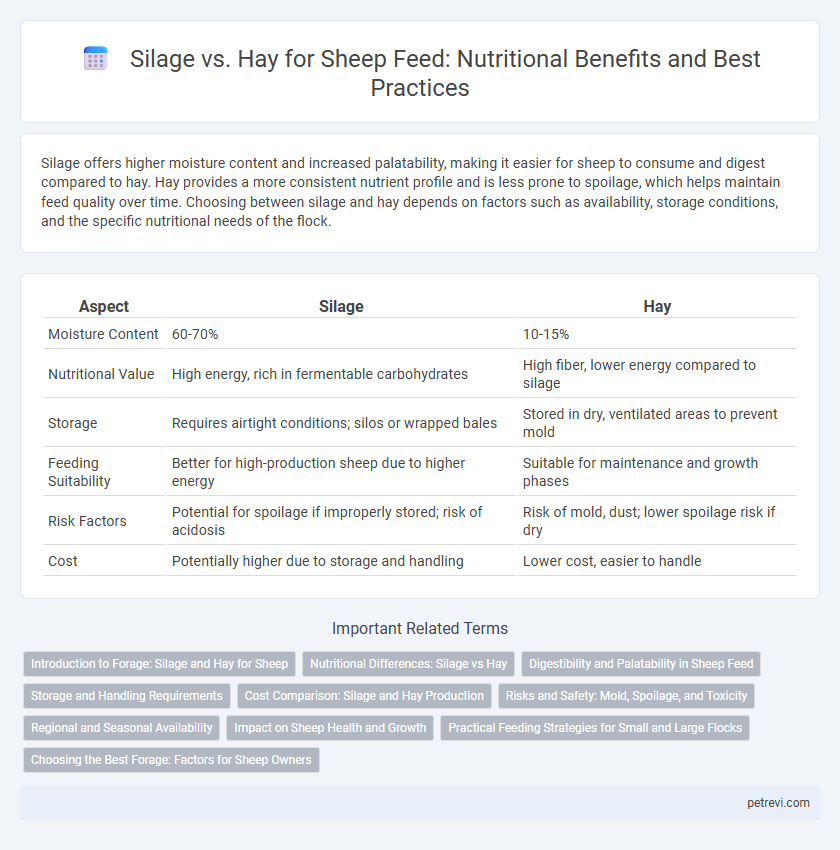Silage offers higher moisture content and increased palatability, making it easier for sheep to consume and digest compared to hay. Hay provides a more consistent nutrient profile and is less prone to spoilage, which helps maintain feed quality over time. Choosing between silage and hay depends on factors such as availability, storage conditions, and the specific nutritional needs of the flock.
Table of Comparison
| Aspect | Silage | Hay |
|---|---|---|
| Moisture Content | 60-70% | 10-15% |
| Nutritional Value | High energy, rich in fermentable carbohydrates | High fiber, lower energy compared to silage |
| Storage | Requires airtight conditions; silos or wrapped bales | Stored in dry, ventilated areas to prevent mold |
| Feeding Suitability | Better for high-production sheep due to higher energy | Suitable for maintenance and growth phases |
| Risk Factors | Potential for spoilage if improperly stored; risk of acidosis | Risk of mold, dust; lower spoilage risk if dry |
| Cost | Potentially higher due to storage and handling | Lower cost, easier to handle |
Introduction to Forage: Silage and Hay for Sheep
Silage and hay are essential forage options for feeding sheep, each offering unique nutritional benefits influenced by harvesting and storage methods. Silage is fermented, high-moisture forage preserved in anaerobic conditions, providing nutrient-rich feed with improved digestibility. Hay is dried forage with reduced moisture content, offering long-term storage benefits and consistent fiber levels critical for sheep digestion.
Nutritional Differences: Silage vs Hay
Silage contains higher moisture content and retains more nutrients such as vitamins and digestible energy compared to hay, making it more palatable and digestible for sheep. Hay, being dried forage, has a lower moisture level and may lose some nutritional quality during curing, especially vitamin A and certain proteins. Nutritional differences impact sheep growth and health, with silage often providing better energy and fiber balance essential for optimal rumen function.
Digestibility and Palatability in Sheep Feed
Silage offers higher digestibility than hay due to its moisture content and fermentation process, which breaks down fibrous material and enhances nutrient availability for sheep. Palatability is generally greater in silage, encouraging consistent intake and improving overall feed efficiency. Hay, while drier and easier to store, often has lower digestibility and palatability, potentially reducing intake and nutrient absorption in sheep.
Storage and Handling Requirements
Silage requires airtight storage in silos or plastic-wrapped bales to ferment properly and prevent spoilage, demanding careful monitoring of moisture levels and temperature. Hay, on the other hand, must be stored in dry, well-ventilated barns or covered areas to maintain its nutritional quality and prevent mold growth. Handling silage involves specialized equipment for feeding and transport, whereas hay is easier to handle but requires protection from rain and damp conditions to avoid nutrient loss.
Cost Comparison: Silage and Hay Production
Silage production generally incurs higher initial costs due to the need for specialized equipment like silos and plastic wrap, whereas hay production requires basic tools such as mowers and balers with lower upfront expenses. Over time, silage can offer cost savings through reduced nutrient loss and better preservation but may involve ongoing expenses for storage and fermentation management. Hay, while cheaper to produce, often results in greater feed wastage and nutrient degradation, impacting the overall cost-effectiveness for sheep feed.
Risks and Safety: Mold, Spoilage, and Toxicity
Silage for sheep feed poses risks of mold growth and spoilage due to its higher moisture content, potentially leading to mycotoxin exposure and toxicity. Hay, when properly dried and stored, has lower moisture levels, reducing the likelihood of mold but can still harbor mold spores if improperly handled. Ensuring proper fermentation in silage and adequate drying in hay is critical to maintaining feed safety and preventing health issues in sheep.
Regional and Seasonal Availability
Silage offers a high-moisture, nutrient-rich feed ideal for regions with abundant forage growth during wet seasons, supporting better digestibility and energy intake in sheep. Hay, being drier and easier to store, is preferred in arid or colder climates where forage availability is limited or seasonal growth is dormant. Regional climate patterns and seasonal forage cycles dictate the optimal choice, with silage favored in temperate, high-yield areas and hay in drought-prone or winter-restricted zones.
Impact on Sheep Health and Growth
Silage offers higher moisture content and better nutrient preservation compared to hay, promoting improved rumen function and faster weight gain in sheep. Hay's lower moisture and fiber content can lead to slower digestion but reduces the risk of mold-related illnesses often associated with poorly fermented silage. Balanced feeding that considers silage quality and hay's fiber benefits supports optimal sheep health and growth performance.
Practical Feeding Strategies for Small and Large Flocks
Silage provides higher moisture content and can enhance nutrient intake for both small and large sheep flocks, especially during wet seasons when hay quality declines. Hay offers a more stable, dry feed option that is easier to store and manage, making it practical for small farms with limited storage space. Combining silage and hay feeding strategies optimizes digestion and nutrient balance, ensuring consistent energy and fiber requirements are met throughout the year.
Choosing the Best Forage: Factors for Sheep Owners
Selecting the best forage for sheep involves evaluating silage and hay based on nutritional content, moisture levels, and ease of storage. Silage offers higher moisture and digestibility, promoting faster weight gain, while hay provides a drier, more stable feed ideal for long-term storage. Factors such as sheep age, pasture availability, climate conditions, and cost must guide sheep owners to optimize feed efficiency and animal health.
Silage vs Hay for Sheep Feed Infographic

 petrevi.com
petrevi.com